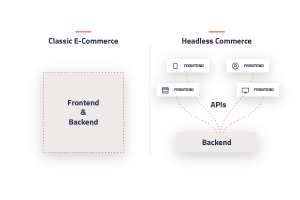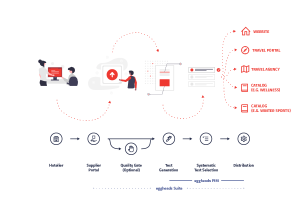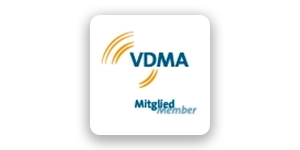Product Information Management
Headless PIM – Mindless or Smart?

Content
Headless Commerce – From Trend to Must-Have in E-Commerce
Within the last few years, the “Headless Commerce” trend has slowly but surely advanced to the position of being an integral part of the e-commerce world. Yet, what does “Headless Commerce,” properly understood, even mean? This concept refers to an architectural approach to e-commerce platforms where frontend and backend are systematically separated from one another, so that both can operate as independently as possible. The big advantage: changes can be made to the frontend – the digital equivalent of the shop window for customers – in a more flexible manner, without requiring adjustments to the corresponding e-commerce processes handled by the backend. Additionally, multiple frontends for different devices or use cases can be developed and connected to one and the same backend more easily. For you and your company, finally, this means: more agility and less effort – and, at the end of the day, this is what we’re all striving for.
However, how can “Headless Commerce” be applied to Product Communication and the management of product information? Is that even possible? The answer to this question is given in our most recent blogpost below – explained in an intuitive manner by following the example of a travel business and tour operator.
Now, what does “Headless” have to do with PIM?
In the original sense of the term “Headless Commerce,” the topic has relatively little to do with Product Information Management. After all, the “Headless Commerce” solution is about utilizing many backend interfaces to allow for simple, agile adjustments to the frontend. A “Product Information Management” (PIM) solution, in contrast, is usually considered to be a pure in-house application – that is to say, software which end consumers will never even come to catch a glimpse of. Which is why the need to make changes to the graphical user interface design in the latter case is considerably lower and does, in general, not warrant developing a dedicated frontend.
Yet, the fact that a PIM backend is equipped with a great many interfaces makes for exciting benefits when it comes to Product Information Management. This way, you can smoothly integrate your system into your IT infrastructure and establish product creation and management processes across multiple systems. “Headless” plus PIM, in short, equals more automation.
Depending on the industry, business model, as well as IT prowess and process management of a company, there’re several interesting use cases for such remote-controlled, “headless” PIM solutions. Let’s now have a closer look at a practice-centered case study from the industry of travel business:
Headless PIM in the Tourism Industry – Automated through and through, from Supplier to Distribution Channels
Headless PIM proves to be more and more popular in the tourism industry. However, why is this solution so interesting here in particular? Let’s take the example of a large tour operator for package tours. The suppliers of our tour operator are airlines, rent-a-car services, and hotels which are bundled together and marketed. For these suppliers, in particular for the hoteliers, the tour operator builds a supplier portal wherein the hotel owners describe their hotels with more than 1,000 facts, hereby creating the product data on their own. Throughout the process, for example, the hotel owners are to answer how many pools the hotel has to offer. Subsequently, further criteria are defined and refined for each pool – from the exact location to the temperature, measures, and much more. Based on these specifications and the images and videos uploaded by the hotel owner, a powerful product data portfolio encompassing every hotel offered by the tour operator can be prepared for the customer.
As soon as the supplier data has reached a degree of refinement that meets the quality guidelines, product content can be generated in a fully-automated manner. This content together with the aforementioned hotel facts and media are now transferred over to the PIM software. With that being out of the way, the hotel is now fully imported into our tour operator’s digital data pool. In the next step, the newly created hotel is introduced automatically to the booking system, which is effectively the travel business equivalent of an Enterprise Resource Planning system. In fruitful exchange, the PIM system receives important intel on how to strategically market the hotel.
For each relevant sales channel in which the hotel is to be promoted, the logic then filters and rearranges the content depending on the channel’s respective target group or other user-defined criteria. For example, people looking for wellness vacations and people looking for sports vacations may be advertised one and the same hotel with different texts and images individualized to appeal to their needs – and all this can be accomplished in a fully-automated manner. On top of being “Headless,” this does also make for a wonderful demonstration of what good and automated product experience looks like! The digital sales channels, too, are directly connected via interfaces, receiving the newest and hottest supplier data nearly on demand.
For the physical print product, there’s also a large field of possibilities when it comes to automation, so that processes can be significantly simplified even in this area. Here, the system knows, for example, how prominent the product presentation is to be and how much dedicated space the respective print page can offer. This way, the automatically-generated enumeration list on the page can be shortened automatically by list points which are the least relevant to the target group. With user-defined and highly dynamic print templates, entire catalogs are generated automatically. Of course, if a text can’t be resized to the necessary format, it’s a job for the members of the content team. In this use case context, the content manager has the option to revise the text, to then proceed by transferring it together with the other automatically shortened texts over to the graphic designer’s fine layout in Adobe InDesign.
Content Automation is King
The solution provided above concerning the example of the travel company demonstrates how almost the complete content creation and distribution process can be automated – namely, through the cross-linking of internal IT systems, on the one hand, as well as onboarding mechanisms and PIM, on the other hand. As a result, our travel business profits from an enormous efficiency, low costs, and an extremely fast time-to-market. It’s “headless,” but far from mindless.
Admittedly, setting things up isn’t an easy task either. The results, however, speak for themselves, so that the time investment and patience does, in fact, pay dividends.
All your product data, information, and images organized in and through a central system?
This is how it’s done, with eggheads Suite!
From Our Blog
You may also be interested in the following articles









